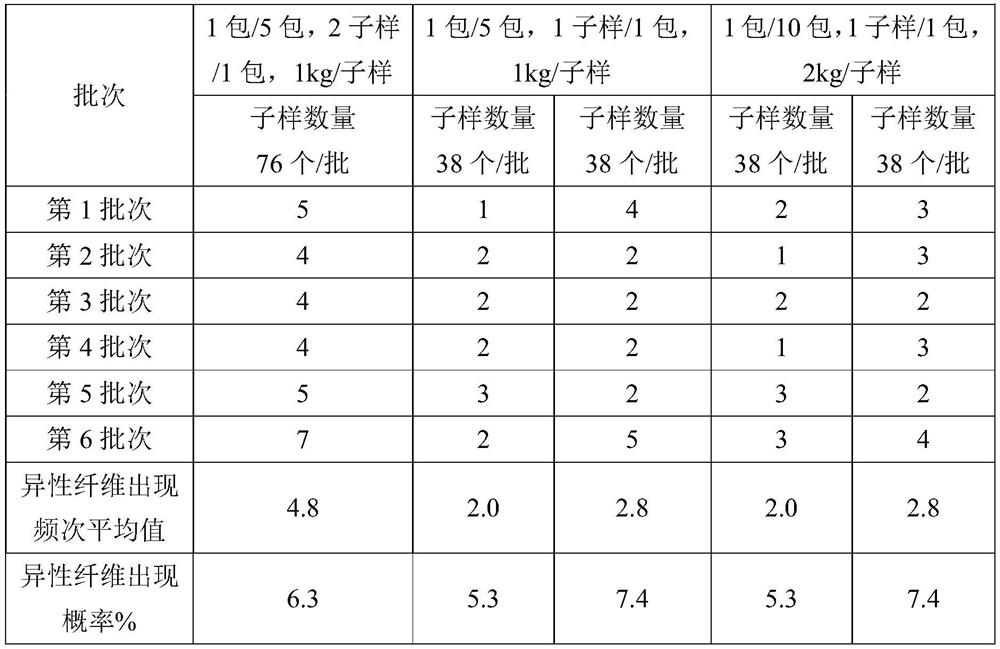Quantitative test method for foreign fibers in raw cotton
A technology of foreign fibers and testing methods, which is applied in textile testing, measuring devices, complex mathematical operations, etc., can solve the problems of unable to truly reflect foreign fibers of raw cotton, inconsistency with actual standards, lack of lint cotton, etc., to solve the quantitative problem of foreign fibers of raw cotton The effect of analysis
- Summary
- Abstract
- Description
- Claims
- Application Information
AI Technical Summary
Problems solved by technology
Method used
Image
Examples
Embodiment 1
[0026] A method for quantitatively testing raw cotton foreign fibers, specifically comprising the steps of:
[0027] (1) Six batches of Xinjiang machine-picked cotton (186 bags / batch, 227kg / bag) were sampled using different sampling methods to analyze the frequency of foreign fibers, as shown in Table 2.
[0028] Table 2 Occurrence frequency of foreign fibers in different sampling methods of machine-picked cotton in Xinjiang
[0029]
[0030] (2) According to the frequency distribution characteristics of foreign fibers in raw cotton, the discrete variable distribution is selected.
[0031] As can be seen from Table 2, the sampling method (1 bag / 5 bags, 2 samples / 1 bag, 1kg / sample, 76 samples / batch), the average number of foreign fiber samples in 76 samples is 4.8; Method (1 bag / 5 bags, 1 sample / 1 bag, 1kg / sample, 38 samples), the average value of foreign fiber samples in 38 samples is 2.0-2.8; sampling method (1 bag / 10 bags , 1 sample / 1 bag, 2kg / sample, 38 samples), the ...
Embodiment 2
[0048] A method for quantitatively testing raw cotton foreign fibers, specifically comprising the steps of:
[0049] (1) Four batches of hand-picked cotton (120 bags / batch, 217kg / bag) were used to test the frequency of foreign fibers by different sampling methods, as shown in Table 5.
[0050] Table 5 Occurrence frequency of foreign fibers in different sampling methods of local cotton
[0051]
[0052] (2) According to the distribution characteristics of foreign fibers in raw cotton, the discrete variable distribution is selected.
[0053] It can be seen from Table 5 that for local cotton, the sampling method (1 bag / 5 bags, 2 samples / 1 bag, 1kg / sample, 48 samples), the average number of samples containing foreign fibers in the 48 samples is 12.25 ; Sampling method (1 pack / 5 packs, 1 sub-sample / 1 pack, 1kg / sample, 24 sub-samples), the average number of foreign fiber sub-samples in 24 sub-samples is 6.0-6.25; sampling method (1 pack / 10 packs, 1 sample / 1 pack, 2kg / sample, 2...
PUM
 Login to View More
Login to View More Abstract
Description
Claims
Application Information
 Login to View More
Login to View More - Generate Ideas
- Intellectual Property
- Life Sciences
- Materials
- Tech Scout
- Unparalleled Data Quality
- Higher Quality Content
- 60% Fewer Hallucinations
Browse by: Latest US Patents, China's latest patents, Technical Efficacy Thesaurus, Application Domain, Technology Topic, Popular Technical Reports.
© 2025 PatSnap. All rights reserved.Legal|Privacy policy|Modern Slavery Act Transparency Statement|Sitemap|About US| Contact US: help@patsnap.com



